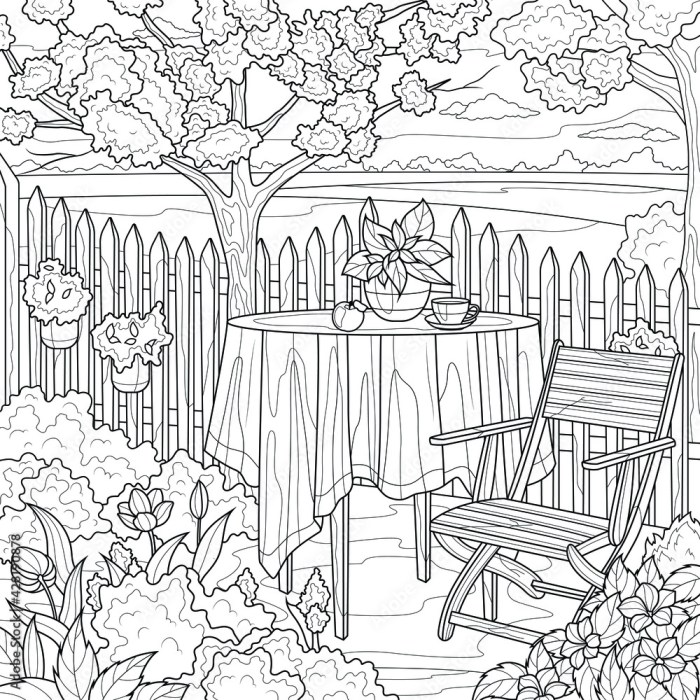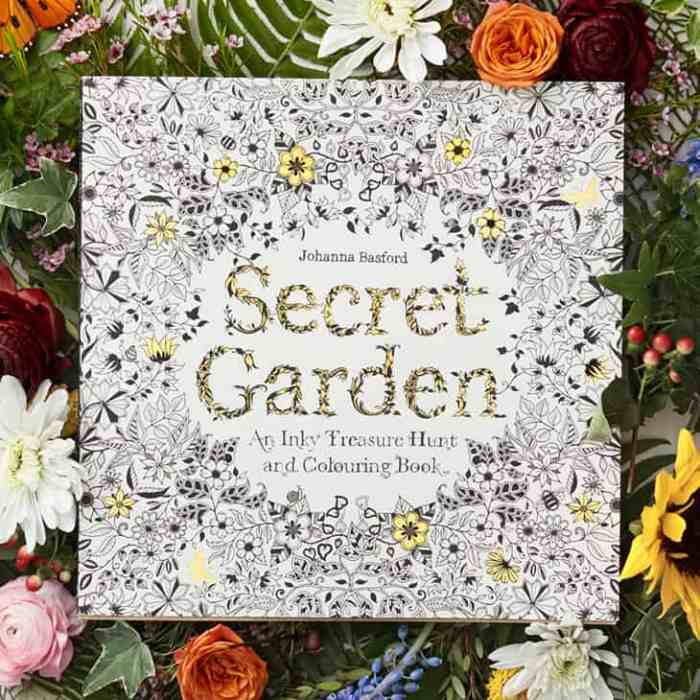Target Audience & Market Research: Botanical Gardens Coloring Book

Understanding the target audience is crucial for the success of a botanical gardens coloring book. This involves identifying the primary age groups interested in this type of product, analyzing their characteristics, and comparing the market demand for adult versus children’s versions. Effective market research helps in tailoring the book’s design, marketing strategy, and overall content to maximize appeal and sales.This section will detail the likely target audiences for a botanical gardens coloring book, outlining their profiles and exploring the market demand for both adult and children’s versions.
We will also look at how these different markets influence design and marketing considerations.
Primary Age Groups and Buyer Characteristics
The primary age groups likely to purchase a botanical gardens coloring book are children (ages 4-12) and adults (ages 25-55). Children are drawn to coloring books for their creative expression and entertainment value, while adults often appreciate them as a relaxing and mindful activity, a creative outlet, or a way to connect with nature.Potential buyers within these age groups share several characteristics.
Children’s parents or guardians are likely to be the primary purchasers, seeking engaging and educational activities for their children. They often prioritize books with high-quality paper, vibrant illustrations, and age-appropriate designs. Adult buyers, on the other hand, may be interested in intricate designs, high-quality paper suitable for various coloring mediums, and calming, nature-inspired themes. Many adult buyers also appreciate the therapeutic benefits of coloring.
They often purchase coloring books online or in bookstores specializing in art supplies and hobby materials.
Market Demand Comparison: Adult vs. Children’s Botanical Coloring Books
The market demand for adult coloring books has seen a significant surge in recent years, driven by the growing popularity of mindfulness and creative activities for stress relief. This trend extends to botanical-themed coloring books, which tap into the broader interest in nature and its calming effects. The market for children’s coloring books remains robust, with consistent demand fueled by parents seeking engaging activities for their children.
Botanical-themed children’s coloring books offer an educational aspect, introducing children to different plants and flowers.While the adult market may offer a potentially higher average price point per book due to more intricate designs and higher-quality paper, the children’s market offers a larger potential volume of sales due to a broader consumer base. Success in both markets requires a tailored approach to design and marketing.
Hypothetical Customer Profiles
To illustrate the different target audiences, let’s create hypothetical customer profiles:
Child Customer Profile: Lily (Age 8)
Lily is an eight-year-old girl who enjoys drawing and coloring. She is fascinated by flowers and plants, often asking her parents questions about them during walks in the park. Her mother, Sarah, frequently purchases children’s books and educational materials for her. Sarah prioritizes high-quality paper and vibrant, age-appropriate illustrations when choosing coloring books for Lily. She often buys books online or at bookstores with children’s sections.
Adult Customer Profile: David (Age 35)
David is a 35-year-old graphic designer who enjoys artistic pursuits as a relaxing hobby. He appreciates intricate designs and high-quality materials. He often seeks out unique and aesthetically pleasing coloring books, preferring those with botanical themes due to their calming effect and the beauty of the natural world. He frequently purchases art supplies and coloring books online from specialized retailers or art supply stores.
He values detailed illustrations and paper that can withstand various coloring mediums like colored pencils, markers, and watercolors.
Design & Illustrations

Creating a visually appealing and engaging coloring book requires careful consideration of page layout, plant illustrations, and artistic style. The goal is to produce a book that is both fun to color and educational, showcasing the beauty and diversity of the plant kingdom. We’ll explore design elements and illustration techniques to achieve this.
Sample Page Layout
A well-designed page layout ensures a balanced and visually pleasing experience for the user. This sample uses a four-column grid to maximize space and provide variety.
|
Column 1: Detailed illustration of a single, large flower (e.g., a vibrant hibiscus with intricate details in petals and stamen). |
Column 2: A cluster of smaller wildflowers, perhaps a mix of daisies and buttercups, allowing for varied coloring approaches. |
Column 3: A delicate fern, emphasizing the fine lines and textures of its fronds, perfect for detailed coloring. So, you’ve got this awesome botanical gardens coloring book, right? Seriously, orchids and ferns? Next level. But to really unleash your inner Monet, you need the right tools. Check out this article on best supplies for coloring books to find the perfect pencils and paper. Then, get ready to make those botanical beauties pop; your coloring book will thank you. |
Column 4: A simple, stylized succulent, providing a contrasting shape and texture to the other elements. |
Plant Species for Illustration
Choosing plants with diverse visual characteristics is key to creating a varied and interesting coloring book. Here are five examples:
- Rose: Known for its intricate petal structure, wide variety of colors and forms (from delicate tea roses to full-blown hybrid teas), offering opportunities for detailed coloring and shading.
- Sunflower: The large, bold central disk and radiating petals provide a striking visual contrast, suitable for both simple and complex coloring styles.
- Orchid: Characterized by their unique and often elaborate flower shapes, orchids offer opportunities for exploring complex color gradients and fine details.
- Cactus: The spiky textures and geometric shapes of cacti provide a different aesthetic, allowing for creative use of line weight and shading techniques.
- Fern: The delicate, feathery fronds of ferns offer a great opportunity for detailed line work and subtle shading to capture their natural texture.
Artistic Styles, Botanical gardens coloring book
The artistic style significantly impacts the overall feel of the coloring book. Different styles appeal to different audiences and allow for varied creative expression.
- Realistic: Focuses on accurate depiction of plant anatomy and color, aiming for photorealism. This style is ideal for those who appreciate botanical accuracy.
- Whimsical: Employs exaggerated features, playful lines, and vibrant colors to create a fun and fantastical representation of plants. This style is engaging for younger audiences.
- Abstract: Simplifies plant forms into basic shapes and colors, emphasizing patterns and textures rather than realistic representation. This style allows for creative interpretation.
- Geometric: Uses geometric shapes to represent plants, creating a structured and modern aesthetic. This style can be both simple and complex depending on the level of detail.
- Line Art: Focuses solely on line work, creating detailed Artikels of plants without shading or color fills. This style is versatile and allows for individual color choices.
Illustration Descriptions
Detailed descriptions are essential for providing guidance on coloring techniques.
- Illustration 1: Sunflower
– Color Palette: Warm yellows, oranges, and browns for the petals and center. Line Work: Bold, defined Artikels for the petals and a more textured, less defined line for the center. - Illustration 2: Orchid
-Color Palette: Cool purples, pinks, and greens with subtle shading to create depth. Line Work: Fine, delicate lines to capture the intricate petal structure. - Illustration 3: Cactus
-Color Palette: Various shades of green, with touches of yellow or pink for flowers (if included). Line Work: Thick, bold lines for the spines and a thinner line for the body of the cactus.
Production & Printing

Getting your botanical garden coloring book from digital design to a printed product involves several key steps. This process requires careful planning to ensure the final product is of high quality and meets your expectations. We’ll walk through the stages, from preparing the artwork to choosing the right paper and binding.The production process begins with finalizing your artwork.
This includes ensuring all illustrations are high-resolution, color-accurate, and properly formatted for print. Next, you’ll create a printer-ready PDF file that includes all the pages in the correct order and orientation. This file should adhere to the specifications of your chosen printing method. After this, you’ll send this file to your chosen printer. They will review the files for any issues, and then the printing process will begin.
Finally, the printed sheets will be bound, trimmed, and packaged ready for sale.
Printing Methods
Offset printing and digital printing are the two most common methods for printing coloring books. Offset printing is best suited for large print runs (typically 500+ copies) due to its lower per-unit cost. It offers superior color accuracy and print quality, resulting in vibrant and sharp illustrations. However, setup costs for offset printing can be higher. Digital printing, on the other hand, is ideal for smaller print runs or when needing quick turnaround times.
It’s more cost-effective for smaller quantities but might not offer the same level of color vibrancy as offset printing. For a first print run of a new coloring book, digital printing allows for a lower risk investment to test the market. A larger second print run could then utilize offset printing if sales are strong.
Paper Types
Choosing the right paper is crucial for a positive coloring experience. The paper should be thick enough to prevent bleed-through of markers or colored pencils, yet smooth enough for easy coloring.
- Thick Cartridge Paper: A good balance of weight and smoothness. It’s a widely available and affordable option that works well with most coloring mediums. It’s a good choice for a wider range of budgets.
- Drawing Paper: Offers a slightly textured surface, which can add a unique aesthetic to the coloring experience. It’s typically heavier than cartridge paper and less likely to show bleed-through. This is a good option for users who prefer a more tactile coloring experience.
- High-Quality Cardstock: A very heavy paper that provides excellent resistance to bleed-through. However, it can be more expensive and may be less suitable for some coloring tools. This is ideal for those seeking the absolute best quality, especially for use with watercolors.
Book Specifications
The physical dimensions and binding type significantly impact the overall look and feel of your coloring book. Consider these specifications when planning your project.Standard coloring book dimensions are typically around 8.5 x 11 inches (letter size) or 8 x 10 inches. However, you could also consider a smaller, more portable size, such as 6 x 9 inches, or a larger format for more detailed illustrations.Saddle stitch binding is the most common and cost-effective method for coloring books.
It involves folding and stitching the pages along the spine. Perfect binding, where the pages are glued to a cover, is another option, but it’s usually more expensive. For a coloring book, saddle stitch is usually sufficient and keeps the cost down.
Q&A
What age range is this coloring book suitable for?
This coloring book is suitable for a wide age range, from children aged 8 and up to adults. The complexity of the designs can be adapted to different skill levels.
What type of paper is used in the book?
We use high-quality, thick paper to prevent bleed-through from markers and colored pencils.
Where can I purchase the Botanical Gardens Coloring Book?
The book will be available online through major retailers and directly from our website, as well as in select bookstores and botanical gardens.
Are there any additional resources available?
We plan to offer downloadable coloring pages and additional botanical information on our website.
